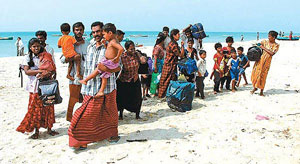People and Migration
Sakshi Education
 Key Points
Key Points - Hundreds and Thousands of people move to urban location from rural areas for education, employment and better opportunities.
- Migration arises out of various social, economic or political reasons. For identifying a person as a migrant, the Census uses two criteria – i). Birth Place – Place where the person was born. ii). Last usual place of residence – A place where the person had stayed continuously for a period of six months or more.
- In India, according to census 2001. About 307 million people have been reported as migrants.
- Marriage is the most common reason for migration of females. Employment or seeking employment is the most common reason for males to migrate.
- Dissatisfaction with employment opportunities in the native place, better opportunity for studies, loss in business, family friends are some reasons that people have stated as reasons for migration.
- A large section of rural workers migrate for a short duration and particularly due to distress caused in rural areas.
- Migration allows households to meet debt and other obligations without having to sell assets.
- Migrant laborers live in hash circumstances and in unhygienic conditions, they suffer from health problems and are prone to disease.
- People with technical skills and professional expertise have migrated to countries such as USA, Canada, UK, Australia and other developed Countries.
- The second type of international migration is unskilled and semi-skilled workers migration to oil exporting countries of the West Asia on temporary contracts.
- The Emigration Act, 1983 is the Indian law governing migration and employment of Indians abroad.
- Migration: Moving of people from one place to another in search of employment and facilities. To move from one region and settle in another. Migration arises out of various social, economic or political reasons.
- Immigration: Migrated into and settle in a foreign country.
- Emigration: Leaving your own country to go and live permanently in another Country.
- Seasonal : Opportunities arise only for a few months in a particular season in a given year.
- Boarder : Staying in hostels for their studies.
- Boundary: Limits or Boards of an area.
- Border : The line that divides two countries
- Service Activities: Transport and communication, financial institutions and banking, insurance and administration activities.
- Emigration Act: The Emigration Act, 1983 is the Indian law governing migration and employment of Indians abroad. It also lays out conditions to safeguard the interests of workers emigrating for employment.
1. Compare and contrast the migration from rural to urban areas and rural to rural areas.
I. Rural to Urban Migration:
- People migrate from rural areas mainly due to in sufficient employment opportunities. Inadequate income available in rural employment.
- People also migrate with the expectation of higher incomes and more opportunities for family members and may be better services.
- Some people from rural areas moving to cities and towns to work in industry and other service activities.
- Drought, less facilities to do business, poor economical conditions of a family education purpose etc. are causes for the rural to urban migration.
- A large section of rural workers migrate for a short duration and particularly due to distress caused in rural areas.
- Towns also appear to offer greater freedom and somewhat less discrimination based on Caste and gender bad social conditions, Quarrels causes migration to those rural areas nearby towns.
- Rural seasonal workers. They shift between their origin (native place) and the destination depending on work and seasons.
- In most cases, Migration is the survival strategy for many families.
I. Impact of International Migration:
- The migration of people from rural to town or another district or state in a country is internal migration.
- Migration may provide an opportunity to escape caste divisions and restrictive social norms and to work dignity and freedom at the destination.
- Migration is to improve the economical condition of the family. The head of the family earn a social sum and sends its major part to his family which boosts the economical position of his family.
- Migrants bring back to the source areas a variety of skills, innovations and knowledge known as “Social remittances”.
- For these people, living conditions in slums in towns and cities is worse. There is no Job security. They continue to live as daily workers.
- The migration of people from one country to other country is called International Migration. The migrants need to avail passport and apply for a visa and work permit.
- The families of international migrants the impact are visible as they are able to pay back loans, buy assets and the standard of life improves.
Short Answer Question
1. Draw a table with following items and summaries various examples in the context of migrant labourers-
1. Draw a table with following items and summaries various examples in the context of migrant labourers-
- Migrant labour
- Reasons for the migrantion
- Living standards of the migrants
- Economic impact on their lives
- Economic impact on the lives of people from where they migrated.
| Sl.No. | Ex:1 | Ex:2 | |
| 1 | Migrant Labor | M. Yadagiri, daily labor, Mahaboobnagar | B.Lalitha Software Engineer Malkajgiri, Hyderabad |
| 2 | Reasons for the Migration | Employment opportunity | Employment in MNC in USA |
| 3 | Living standards of the migrants | Economically moderate | Bright economic conditions prevailed |
| 4 | Economic impact in their lives | Economically better position | She is leading very luxurious life with her family |
| 5 | Economic impact on The lives of people From where they migrants | No change on the lives of people from there he migrants | She purchased a house, 5 acres of land, has many fixed deposits at banks etc. |
2. Which of the following could be considered as seasonal migration? Why?
Ans: b & c – They are considered as seasonal migrants, they work is the other places for only a few months in a year
3. Do you think migrants are trouble makers / trouble shooters in their destinations? Justify your answers.?
3. Do you think migrants are trouble makers / trouble shooters in their destinations? Justify your answers.?
- Normally, the migrants are not trouble makers. But in some cities some migrants may create some troubles.
- Living conditions in slums in towns and cities is worse because space is cramped and basic facilities such as drinking water and sanitation are not available for these migrants. In this aspect they are trouble makers in the urban areas.
- Some portions of the urban crime are related to the migrants. Crime rate in the towns and cities may be increased with migrants. Ex migrants from Bihar and up engage in robberies
- People going from India to Saudi Arabia to work as technicians.
- Agricultural labourers going from Bihar to Punjab
- Brick workers going from Odisha to Andhra Pradesh.
- Teachers coming from China to India to teach Chinese to Indian children.
Ans: A) Internal Migrants: (b) & (c) --- B) International Migrants: (a) & (d)
5. Most children of migrant families become drop-outs. Do you agree with this statement? Justify your answer?
5. Most children of migrant families become drop-outs. Do you agree with this statement? Justify your answer?
- When families migrate, Children accompanying their parents do not have crèche facilities. Grownup children are not able to continue their studies at their parents’ new work places.
- Schools in their native place refuse to take them again when they comeback. They finally become dropouts.
- When male leave their families, it becomes a major challenge for women who have to take care of all the responsibilities of the family and elderly people who need care.
- Young girls in such families are required to take care of siblings and as a result many of them become dropouts.
- The rural to urban migrants find good earning opportunities on cities or town and send more to the family on a regular interval.
- The income of the family member of migrants can be used for the purchase of the necessary goods and services.
- Thus, the rural to urban migration increases the purchasing power of people in rural areas and helps the people in rural areas to improve their life style.
- Developed countries need professionals of other countries to work in their IT companies to bring development.
- They have attained all types of infrastructure and other developments in all sectors. Therefore, those countries require only professionals.
- Professionals are needed in every part of the world. Better standard of living, high salaries, access to advanced technology and stable governments in the developed countries attract skilled professionals from developing countries.
- West Asia countries are under developed. They need only unskilled workers to work in their industries for a lower wages.
- These countries need only non-technical and unskilled workers on large scale with lower wages.
- Hence, West Asia countries need unskilled workers from India to work in their oil exporting companies.
- As the workers of Andhra Pradesh, Kerala and Tamil Nadu are good, hardworking and capable of leaving their family members at their hometowns for earning, most of the migrants are from three states in West Asian countries.
- West Asia needs unskilled workers from south India to work in their construction projects, maintenance, service, and transport and telecommunication activities.
- All these workers come back after a specific period depending on the employment situation in the destination countries
Published date : 18 Dec 2014 07:40PM


















